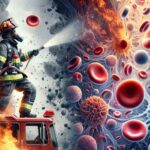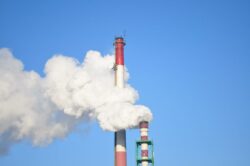Breast Cancer Risk Factors in Female Firefighters With AFFF Exposure
We've found that AFFF, containing PFAS chemicals, notably raises breast cancer risks among female firefighters. These substances, known for their persistence and bioaccumulation, enter the body through inhalation or skin contact during firefighting activities, leading to elevated blood serum levels and an increased health risk. Recognizing these unique occupational hazards, it's vital that we push for protective measures and explore safer alternatives to AFFF. Legislation and improved health protocols are needed to mitigate these risks. By addressing these concerns, we aim to safeguard our firefighters and promote a healthier work environment. Further exploration offers insights into mitigating these adverse effects.
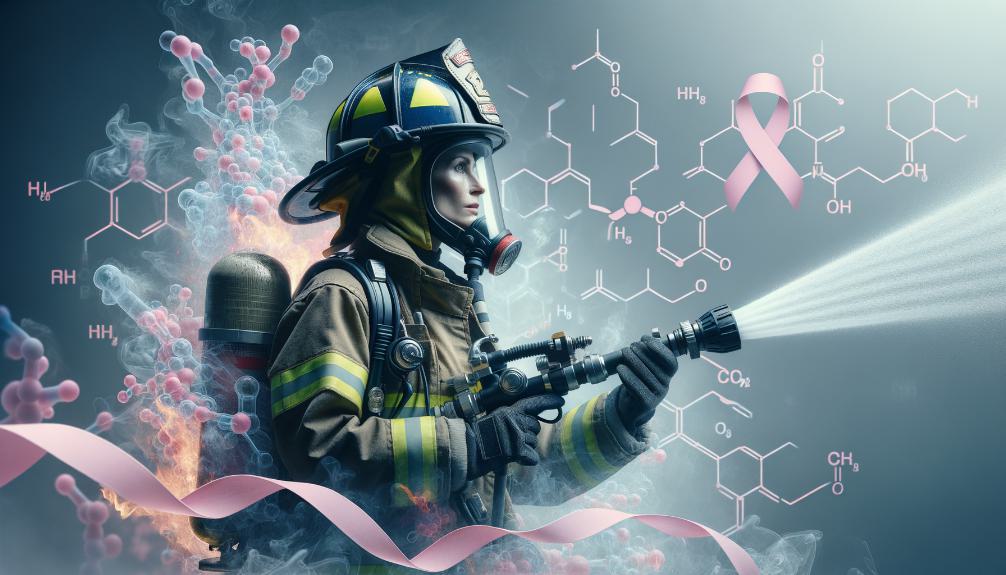
Key Takeaways
- AFFF contains PFAS chemicals, which are known to elevate breast cancer risk in female firefighters.
- Female firefighters are exposed to PFAS through inhalation and skin contact with AFFF and contaminated gear.
- Persistent exposure to PFAS compounds in AFFF is directly correlated with increased breast cancer rates among female firefighters.
- Elevated PFAS levels in blood serum of female firefighters indicate a higher risk of developing breast cancer.
- Identifying and reducing exposure to AFFF and PFAS chemicals are crucial for lowering breast cancer risk in female firefighters.
Understanding AFFF
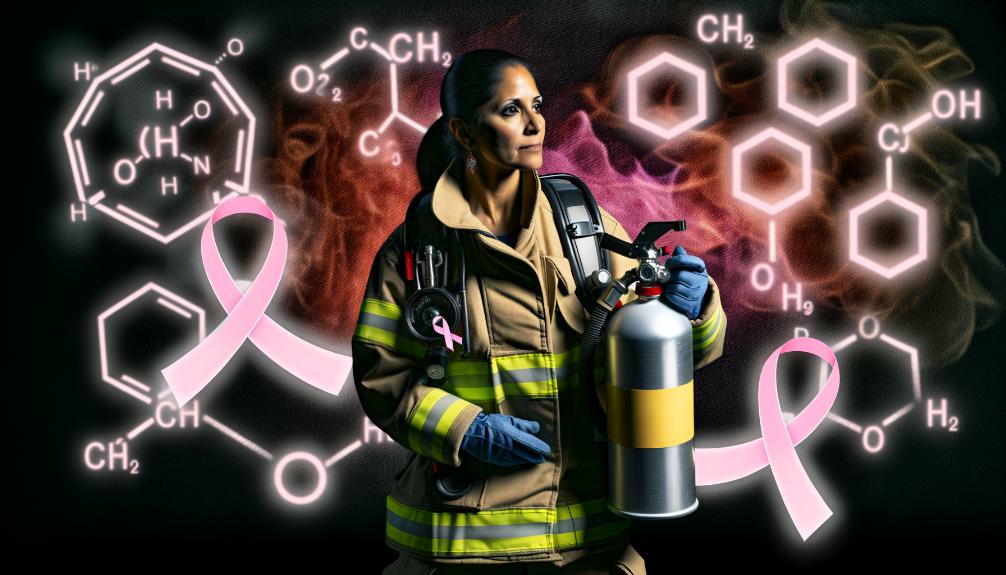
Aqueous Film-Forming Foam, or AFFF, is a firefighting agent loaded with PFAS chemicals that we're scrutinizing for its role in elevating breast cancer risks among female firefighters. This firefighting agent, primarily used to extinguish fires involving flammable liquids like jet fuel, has become a focal point in our investigation due to its potential health risks. Given its widespread use, it's imperative to understand how AFFF exposure could impact the health of female firefighters, particularly concerning breast cancer.
The core of our concern lies in the PFAS chemicals contained in AFFF. These substances, notorious for their persistence in the environment, can contaminate water sources and soil, posing a long-term exposure risk not only to firefighters but also to communities. For female firefighters, who are already at a heightened risk for breast cancer due to the nature of their work, exposure to AFFF could further compound their cancer risk.
In our exploration of breast cancer risk factors, we're particularly focused on how AFFF use and exposure align with increased health risks. The correlation between AFFF exposure and elevated breast cancer risks in female firefighters is drawing significant attention, prompting a deeper examination into the mechanisms by which PFAS chemicals may contribute to cancer development. As we continue to gather data and analyze trends, it's clear that our understanding of AFFF and its potential impact on female firefighters is vital in developing strategies to mitigate these health risks and protect those who serve our communities.
PFAS Chemicals Overview
Having established the link between AFFF exposure and breast cancer risks in female firefighters, it's important we now focus on the PFAS chemicals responsible for these concerns. PFAS, or per- and polyfluoroalkyl substances, are a class of chemicals that have raised significant health alarms due to their importance and toxicity. These substances are prevalent in firefighting foam, specifically AFFF, and gear, making exposure a critical issue for female firefighters.
The concern with PFAS lies in their long half-life and ability to bioaccumulate in the environment and human bodies. This accumulation leads to extensive exposure, with common compounds like PFOA and PFOS being particularly notorious for their environmental persistence. The health effects linked to PFAS exposure are alarming and include cancer, immune suppression, metabolic disturbances, and organ damage. For female firefighters, the presence of PFAS in firefighting materials escalates the breast cancer risk, underscoring the significance of addressing this issue.
PFAS's widespread use and durability mean that they remain in the environment and the body for extended periods, complicating efforts to mitigate their impacts. The bioaccumulation of these substances further exacerbates their health risks, as they build up in the human body over time, increasing the likelihood of adverse outcomes. Given these factors, it's clear why the presence of PFAS in firefighting foam and gear is a significant concern for the health of female firefighters, particularly regarding breast cancer risk. Understanding the nature and effects of these chemicals is important in developing strategies to protect those most at risk.
Sources of Exposure

We must explore the different sources of PFAS exposure, especially through AFFF, to fully comprehend its implications for female firefighters' breast cancer risk. Aqueous Film-Forming Foam (AFFF) is significantly used in firefighting activities, serving as a major source of PFAS exposure. This foam is essential in extinguishing fuel fires, yet it contains PFAS chemicals that, unfortunately, pose health risks. These chemicals can leach into the environment, contaminating the immediate vicinity where firefighting activities occur.
Female firefighters are particularly at risk as they come into direct contact with AFFF. This exposure happens through skin contact and inhalation, pathways that facilitate the entry of PFAS into the body. The nature of firefighting equipment and the scenes of fires themselves are potent sources of exposure. Equipment used in firefighting, often treated or contaminated with AFFF, can carry PFAS, heightening the risk for those in close and frequent contact.
The presence of AFFF in firefighting scenarios contributes to elevated levels of PFAS in female firefighters, potentially increasing their risk of developing breast cancer. It's important to acknowledge these sources and pathways of AFFF exposure to assess accurately the breast cancer risk factors associated with PFAS exposure among female firefighters. Understanding these sources is a step forward in mitigating the risks and safeguarding the health of those bravely serving in firefighting roles.
Occupational Hazards
Understanding the occupational hazards faced by female firefighters, it's evident that AFFF exposure greatly raises their risk of developing breast cancer. The role of AFFF, a firefighting foam, in this heightened risk cannot be overstated. Its use, essential in combating fuel fires, inadvertently exposes firefighters to PFAS chemicals, substances linked to a variety of health issues, including an increased cancer risk.
Particularly concerning for female firefighters is the direct correlation between AFFF exposure and elevated rates of breast cancer. This specific occupational exposure sets them apart from many other professions, underscoring the unique risks they face daily. The presence of PFAS chemicals in AFFF is a significant factor; these compounds are known for their persistence in the environment and the human body, leading to long-term health implications.
Our discussion on occupational hazards reveals that AFFF use in firefighting is more than a necessary tool—it's a source of serious health risks. The connection between specific occupational exposures like AFFF and the heightened risk of breast cancer in female firefighters is clear. These findings emphasize the urgent need for strategies to mitigate these risks, including exploring safer alternatives to AFFF and implementing protective measures for those exposed.
Breast Cancer and PFAS
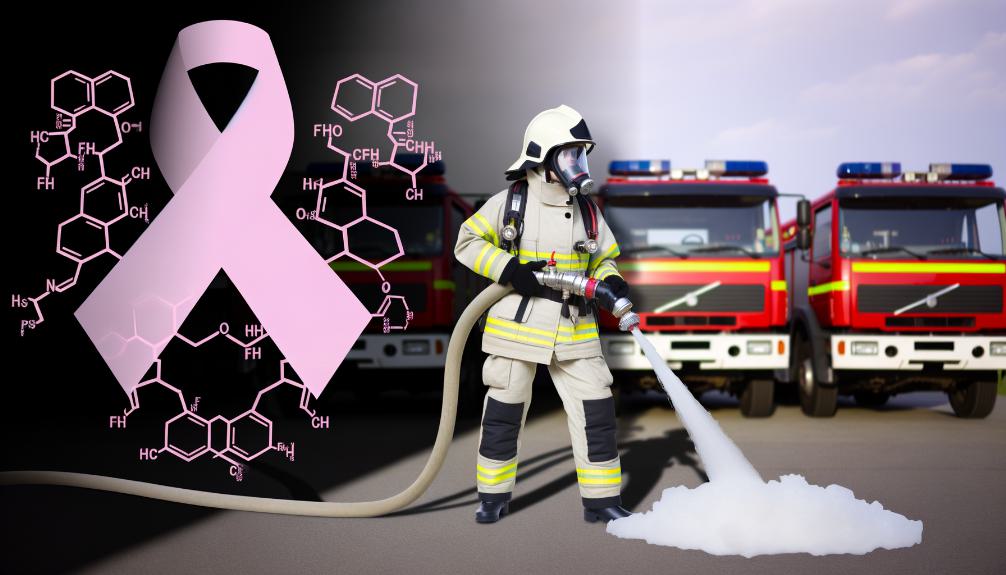
PFAS chemicals in AFFF greatly elevate the risk of breast cancer among female firefighters, highlighting a critical health concern. These substances, prevalent in firefighting foam and gear, have become a significant factor in the occupational exposure that contributes to the heightened breast cancer incidence in this group. Research shows that female firefighters are at an increased risk due to their routine encounters with AFFF, which is laced with these hazardous chemicals.
Our understanding of the link between PFAS exposure and breast cancer in female firefighters has deepened, emphasizing the urgent need for protective measures and regulations. The elevated levels of PFAS found in the bodies of these women underscore the pervasive nature of this exposure and its potent impact on their health. It's not just the direct contact with AFFF during fire suppression activities but also the cumulative effect of ongoing exposure that's alarming.
This situation calls for a reevaluation of the materials and methods used in firefighting. The presence of PFAS in the firefighting environment, particularly in AFFF, presents a specific and concerning cancer risk for women firefighters. Their dedication to protecting communities should not come at the cost of their health. As we continue to explore the correlation between PFAS exposure and breast cancer incidence, it's clear that more stringent safety protocols and alternatives to PFAS-containing firefighting foams are necessary.
AFFF in Firefighting Gear
Having explored the broader issue of PFAS chemicals in AFFF and their impact on breast cancer risk, it's now essential to focus on the specific role of firefighting gear as a conduit for exposure. Aqueous Film-Forming Foam (AFFF), commonly utilized in this gear to suppress flammable liquid fires, contains Per- and Polyfluoroalkyl Substances (PFAS) that may leach into the environment, presenting significant health risks. This is particularly concerning for female firefighters, who may be exposed to these chemicals through contaminated gear, elevating their breast cancer risk due to the persistence and bioaccumulation of PFAS.
The relationship between AFFF in firefighting gear and health risks underscores the importance in addressing exposure risks. It's critical to recognize that firefighting gear, while essential for safety, can inadvertently act as a vehicle for PFAS exposure. This reality necessitates the implementation of stringent protocols for the handling and disposal of AFFF-containing gear to mitigate exposure risks among female firefighters. Ensuring that these professionals are equipped with gear that minimizes PFAS exposure is paramount in safeguarding their health.
Blood Serum PFAS Levels

In light of AFFF usage in firefighting, we're seeing increased blood serum PFAS levels among female firefighters, signaling a potential health concern. This uptick in PFAS levels is especially concerning given the connection between Aqueous Film-Forming Foam (AFFF) exposure and various health risks. The evidence we're gathering suggests that the elevated blood serum PFAS levels in female firefighters could greatly contribute to a higher likelihood of PFAS accumulation, which in turn, raises the potential for adverse health effects.
Monitoring these PFAS levels in blood serum is vital for evaluating the extent of AFFF exposure among female firefighters. It serves not just as a marker of exposure but also acts as an early warning system for potential health issues that may arise as a result of their profession. The correlation between AFFF exposure and increased blood serum PFAS levels cannot be overlooked, especially considering the potential impact on breast cancer risk.
As we explore further into the health implications of AFFF exposure, it becomes increasingly evident that understanding these PFAS levels in blood serum is not just about gauging exposure. It's about piecing together a puzzle that links occupational hazards to long-term health outcomes. For female firefighters, the stakes couldn't be higher. The findings suggest a pressing need for strategies to mitigate exposure and safeguard their health against the backdrop of their critical, life-saving roles. Recognizing the correlation between elevated PFAS levels and breast cancer risk is a vital step in developing more thorough health monitoring and preventive measures for those on the front lines.
Exposure Pathways
In examining the exposure pathways of AFFF, we discover that inhalation risks and skin contact concerns are vital for female firefighters. These exposure methods enable PFAS chemicals to enter the body, greatly increasing the risk of breast cancer. It's essential that we comprehend how these pathways contribute to the accumulation of PFAS, leading to long-term health implications.
AFFF Inhalation Risks
Among the various ways female firefighters are exposed to harmful chemicals, inhalation of AFFF stands out as an important pathway leading to increased breast cancer risk. Aqueous film-forming foam, or AFFF, is a firefighting foam that, when inhaled, introduces PFAS chemicals directly into the respiratory system. These PFAS compounds are notorious for their link to breast cancer risk. Our exposure to these dangerous substances isn't limited to actual firefighting incidents but extends to training exercises as well, where AFFF is commonly used. This puts us at a continual risk of inhaling these harmful chemicals. It's essential to understand that AFFF inhalation risks are a significant concern for us, as the PFAS chemicals contained in these firefighting foams can directly impact our health, specifically increasing the risk of breast cancer.
Skin Contact Concerns
Frequently, we're exposed to AFFF through skin contact during firefighting activities, presenting a significant pathway for PFAS chemicals to enter our bodies and potentially increase breast cancer risk. As female firefighters, our direct handling of Aqueous Film-Forming Foams (AFFF) and contaminated gear exposes us to these harmful chemicals. The skin absorption of PFAS from AFFF can lead to their systemic distribution within our bodies, marking a silent yet potent threat. Our close contact with AFFF during fire suppression efforts is not just about battling flames but also confronting a direct route of exposure to carcinogenic substances. This exposure significantly impacts our breast cancer risk, underscoring the need for heightened awareness and protective measures against skin contact with these dangerous chemicals.
Cancer Risk Assessment
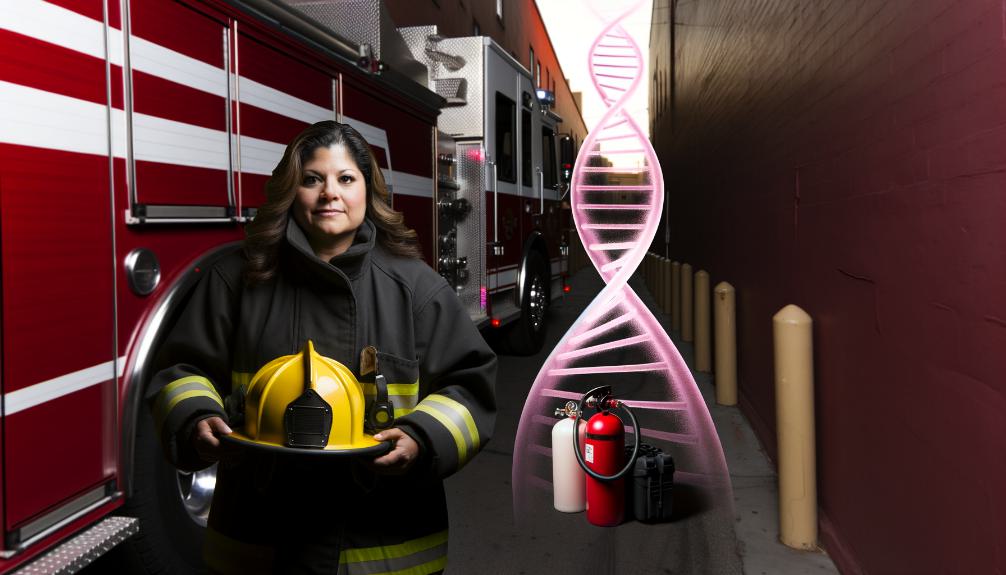
As we explore the cancer risk assessment for female firefighters exposed to AFFF, it's important to identify the key risk factors linked to this dangerous exposure. The implications of AFFF exposure on breast cancer development cannot be understated, considering the significant correlation found in recent studies. Our focus will be on understanding these risk factors and the role of AFFF in elevating breast cancer risk among these brave women.
Identifying Key Risk Factors
To accurately evaluate breast cancer risk in female firefighters, it's essential that we identify key risk factors associated with AFFF exposure. Studies have emphasized that female firefighters are at a unique risk due to occupational exposures to AFFF, a foam used in firefighting that contains PFAS chemicals. These chemicals are of particular concern because they've been linked to an increased risk of breast cancer. By analyzing risk factors, including specific chemical exposures like PFAS in AFFF, we're taking essential steps towards understanding the magnitude of breast cancer risk among female firefighters. It's important to explore occupational exposures to AFFF and related chemicals to pinpoint key risk factors, thereby enhancing our strategies for protecting the health of female firefighters against breast cancer.
AFFF Exposure Implications
Understanding the implications of AFFF exposure on the cancer risk for female firefighters, we'll now examine how this specific occupational hazard contributes to an increased likelihood of developing breast cancer. Aqueous Film-Forming Foam, known as AFFF, is particularly concerning due to its PFAS chemicals content, directly linked to a heightened breast cancer risk among female firefighters. These professionals might exhibit elevated PFAS levels in their blood serum, further emphasizing the potential cancer risk. Additionally, the migration of PFAS from AFFF in firefighting gear could greatly amplify this risk. Considering these factors, it's evident that AFFF exposure emerges as a critical element in evaluating breast cancer risk, underscoring the need for vigilant monitoring and protective measures for our female firefighters facing this occupational hazard.
Protective Measures
In light of AFFF exposure risks, we must prioritize wearing proper personal protective equipment (PPE) during firefighting operations to safeguard female firefighters' health. This protective measure is essential, as it directly mitigates the risk of absorbing harmful chemicals present in AFFF. Regular decontamination practices, such as showering immediately after exposure, play a pivotal role in minimizing these risks. It's important that we rigorously adhere to these protocols to guarantee our safety.
Moreover, implementing strict hygiene practices, including the regular cleaning of gear and equipment, is fundamental in reducing AFFF exposure. These measures not only protect us on the frontline but also prevent the contamination of our personal environments, thereby safeguarding our long-term health. Training on the safe handling and disposal of AFFF is another critical protective measure. It equips us with the necessary knowledge to minimize exposure not only to ourselves but also to the environment.
We're also advocating for the use of alternative firefighting foams that do not contain PFAS. This shift is significant, as it could drastically reduce the health risks associated with AFFF exposure. By exploring and encouraging the adoption of these alternatives, we're not only safeguarding our health but also leading by example in the pursuit of safer firefighting methods.
Research on Female Firefighters
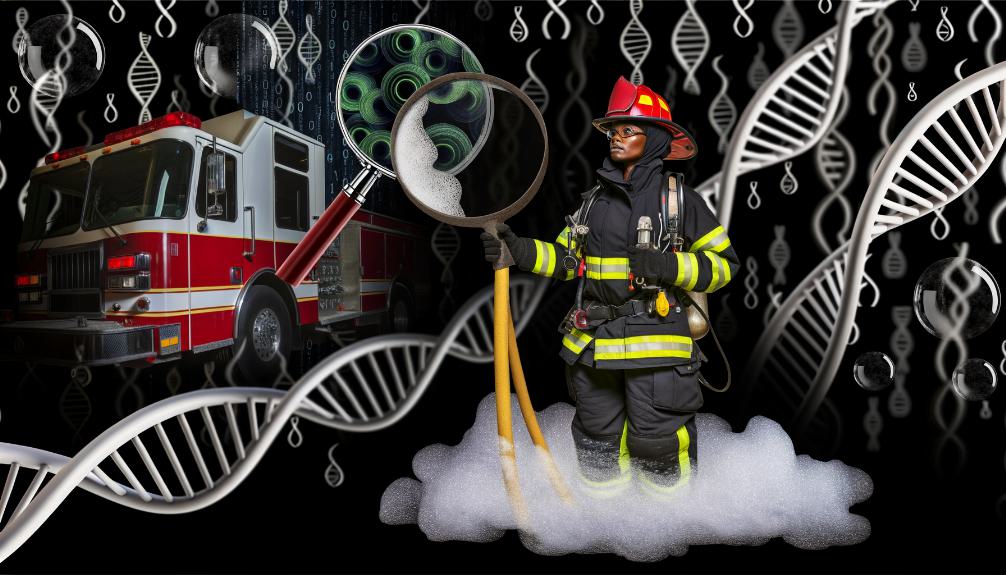
We're now turning our attention to the essential research concerning female firefighters, specifically focusing on occupational hazards assessment, AFFF exposure analysis, and health impact studies. This exploration is pivotal as it sheds light on the unique risks these brave women face, particularly the connection between AFFF exposure and increased breast cancer risk. There's an urgent need for more thorough studies to better understand and mitigate these risks, ensuring the safety and health of female firefighters.
Occupational Hazards Assessment
Evaluating the specific occupational hazards that female firefighters face, especially AFFF exposure, is essential for identifying and reducing their breast cancer risk. Research underscores the need of pinpointing these specific occupational risks to curtail breast cancer incidence among this demographic. By focusing on AFFF exposure, we're able to understand its significant impact on increasing breast cancer risk in female firefighters. This knowledge is pivotal for crafting targeted prevention strategies. Moreover, the call for tailored interventions is loud and clear. These customized approaches aim to mitigate the occupational hazards tied to AFFF exposure, ensuring a safer working environment. Through such dedicated efforts, we move closer to safeguarding our female firefighters from the elevated breast cancer risks associated with their noble profession.
AFFF Exposure Analysis
Having emphasized the need for targeted prevention strategies against occupational hazards, let's now examine the specific research findings on AFFF exposure among female firefighters and its link to increased breast cancer risk. Studies have shown that female firefighters exposed to Aqueous Film-Forming Foam (AFFF), which contains PFAS chemicals, demonstrate elevated risk factors for developing breast cancer. This exposure analysis underscores the significant correlation between AFFF exposure and the heightened breast cancer risk among these professionals. The presence of higher PFAS levels in female firefighters who have been exposed to AFFF suggests an essential contribution to these elevated cancer risks. Understanding this correlation is vital for developing interventions to mitigate these risks and protect our female firefighters from such severe health outcomes.
Health Impact Studies
Recent studies highlight the concerning breast cancer rates in female firefighters, attributing a significant role to occupational exposures, including AFFF. In San Francisco, where a significant number of female firefighters serve, research studies have revealed that 15% of those aged 40-50 face breast cancer diagnoses, a surprising statistic that underscores the seriousness of cancer risks tied to their profession. These findings have propelled health impact studies into the spotlight, focusing sharply on AFFF exposure as a crucial factor. However, the lack of data specific to occupational cancer risks among female firefighters emphasizes an urgent need for thorough research. This gap in knowledge demands our immediate attention to protect those who risk their lives for our safety.
Policy and Health Recommendations

To mitigate the increased risk of breast cancer among female firefighters exposed to AFFF, we must push for stricter regulations on firefighting foams and enhance occupational health protocols. Legislation like SB 1044, which bans firefighting foam containing PFAS chemicals, is an essential step in reducing exposure risks. These chemicals are a known factor in the heightened breast cancer risk for those working in the fire service. However, our efforts can't stop there.
Presumptive laws that recognize breast cancer as a work-related illness for firefighters, such as those adopted in San Francisco, are crucial. They not only acknowledge the link between AFFF exposure and breast cancer but also guarantee that affected female firefighters receive the support and benefits they deserve. This acknowledgment is a significant win in our ongoing advocacy efforts for the health and safety of our colleagues.
Furthermore, occupational health recommendations are clear: female firefighters must inform their healthcare providers about their AFFF exposure. This awareness can lead to early detection and appropriate cancer screening, improving treatment outcomes to a great extent. Our advocacy doesn't end with legislation and healthcare; it extends to supporting initiatives like the Women Firefighters Biomonitoring Collaborative. This group's work in measuring PFAS exposure levels among female firefighters is instrumental in informing both policy and health recommendations aimed at reducing breast cancer risks.
Our collective efforts in pushing for safer alternatives in firefighting materials, alongside robust health protocols and supportive legislation, are essential in protecting our female firefighters from the dangers of AFFF exposure and the associated risk of breast cancer.
Support and Resources
Where can female firefighters exposed to AFFF find the support and resources they need to combat the increased risk of breast cancer? It's important to recognize the unique challenges they face due to occupational exposure to PFAS chemicals, which have been linked to an elevated breast cancer risk. To address these challenges, access to specialized cancer screening programs is essential. These screenings are tailored to identify breast cancer at its earliest and most treatable stages, specifically for those with a history of AFFF exposure.
Moreover, educational programs play a pivotal role in raising awareness among female firefighters about the potential health risks associated with their profession. By understanding the connection between AFFF exposure and breast cancer risk, they can take proactive steps in monitoring their health and seeking appropriate care.
Collaborative initiatives are also crucial in providing support and resources. These initiatives bring together health professionals, cancer researchers, and firefighting communities to develop strategies that mitigate the impact of occupational exposure to carcinogens. Through such collaboration, female firefighters can access a wealth of information, guidance, and assistance tailored to their specific needs.
Ultimately, it's about creating a supportive environment where female firefighters are empowered with the knowledge and resources to effectively manage their health risks. By focusing on specialized cancer screening, educational programs, and collaborative initiatives, we can guarantee that these brave women have the support they need to address the increased risk of breast cancer associated with AFFF exposure.

This post has been generated by AI and was not reviewed by editors. This is Not legal advice. Please consult with an attorney.

